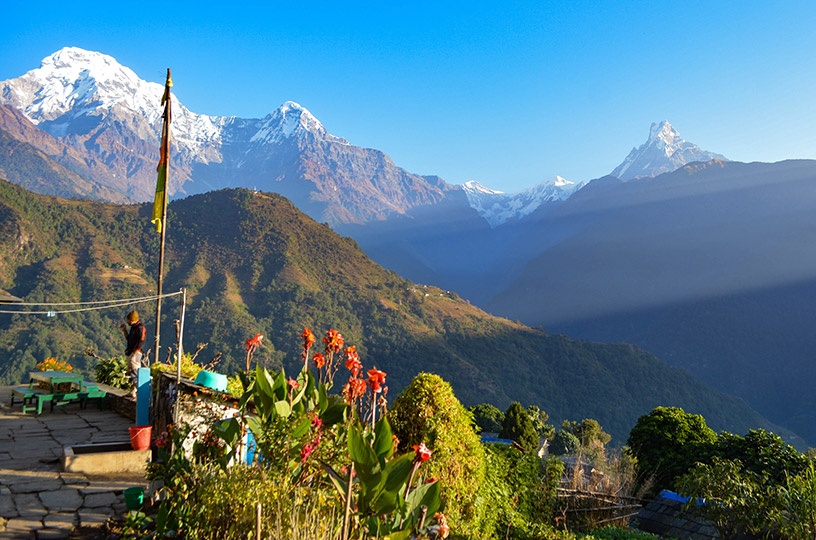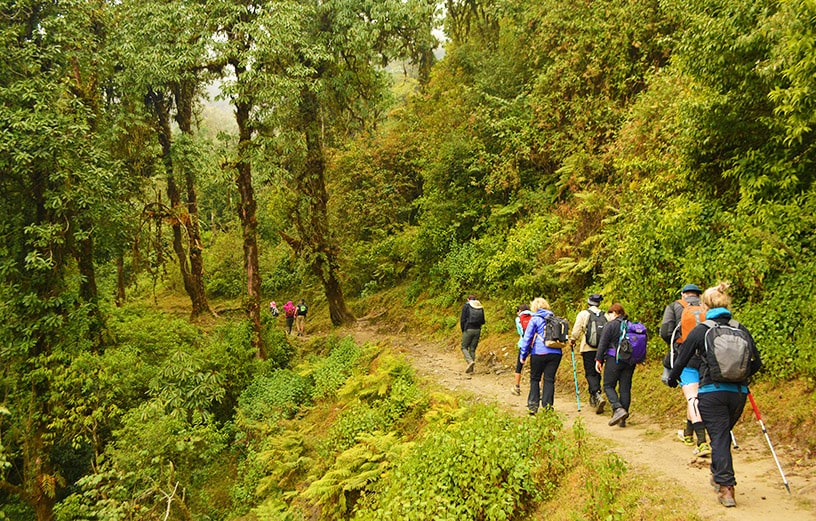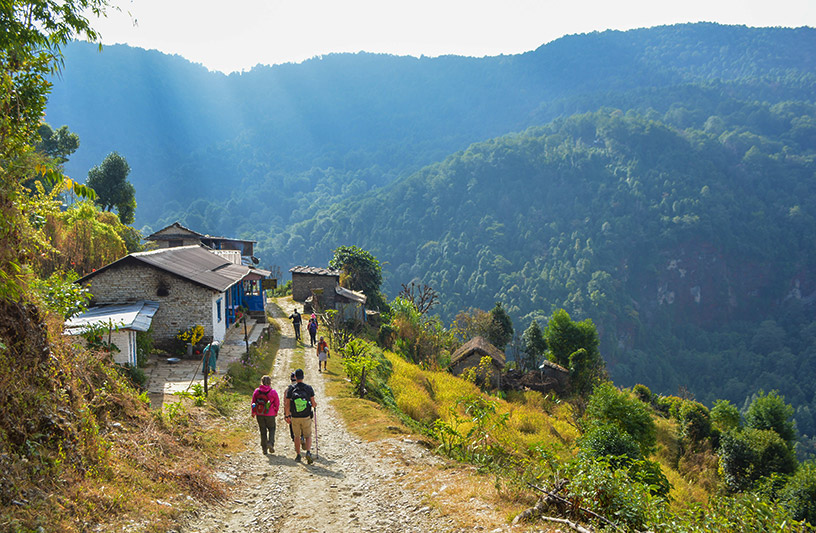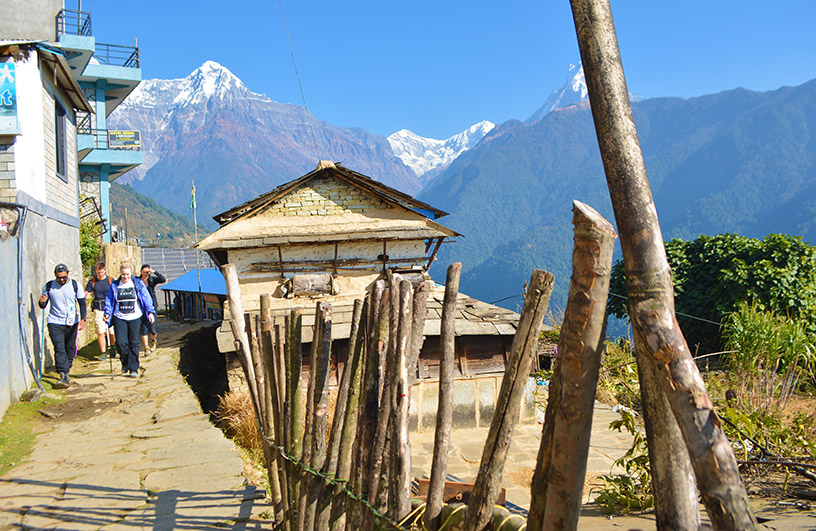Know before you go: Trekking in Nepal
Whether you’re only trekking for a couple of days near Pokhara, making the journey up to Everest Base Camp, or heading out on the Annapurna Circuit, here’s what you need to know before you hit the trails in Nepal.
Check out my quick summary below if you're short for time or continue reading further for more detail.
Tips for trekking in Nepal
- Hire trekking items in Kathmandu or Pokhara
- Bring water purification tablets
- Spend your nights in teahouses
- Layers are essential
- Bring cash as no ATMs are on the trail
- Buy snacks on the trail
- Be prepared for all weather conditions
- Bring bandaids
- Packing list for trekking in Nepal
Find out the details about each one of my tips below!
This can certainly help you out and ease some of your nerves about your upcoming trek.
Consider Cover-More's adventure travel insurance to protect you on your next trip.
1. You can hire many trekking items in Kathmandu or Pokhara
One of the biggest things I wish I’d known before I arrived in Nepal is that you can buy most trekking items (especially clothing) when you arrive.
If I’d known this, I wouldn’t have carried my thermals for the four months I was backpacking before I reached Nepal!
There are lots of trekking stores across Kathmandu’s Thamel district and in the main streets of Pokhara.
Yes, most of it is imitation brand name gear made locally, but if you’re after basic hiking gear, it will do the job and it’s super cheap.
If you do want the real thing or you’re going high altitude and need something that’s guaranteed to withstand sub-zero temperatures, there’s a genuine North Face store in Kathmandu as well.
Items like sleeping bags, jackets and trekking poles are all easily hired from hiking outlet stores in Kathmandu or Pokhara from as little as a dollar a day.
You can also buy backpacks, clothing, water bottles, batteries and torches.
Pretty much everything related to trekking can be found somewhere in Kathmandu.
2. Bring water purification tablets
Bringing water purification tablets for your trek offers a more convenient, cheaper and environmentally friendly alternative than buying water along the trail.
The last thing you want to do while you’re trekking in Nepal is searching desperately for bottled water. Dehydration at altitude is especially dangerous.
So be prepared by bringing water purification tablets and a hydration pack. You can easily buy reusable water bottles in Kathmandu or Pokhara.
3. You’ll spend your nights in teahouses
During your trek, you’ll be staying at teahouses along the way. The teahouses offer basic accommodation and feature a range of twin or triple bed rooms.
Pillows are provided – and sometimes a blanket – but you may want to bring your own sleeping bag. Sleeping bags can be easily hired in Kathmandu or Pokhara.
The teahouses sometimes have hot showers but don’t count on it. The hot water might last 10 seconds or a few people might get through until the hot water runs out. Sometimes you will have to pay for a shower – expect to pay a dollar or two.
The teahouses offer shared facilities outside the rooms, usually there’s one squat toilet and one Western toilet. The hand basin is located on the outside of the facilities – you might find soap, you might not. You’ll need to bring your own toilet paper.
The teahouses will also be where you’ll get your meals. Teahouse meals vary with some offering only Nepalese meals, while some offer Western meals like pizza and pasta.
For breakfast - porridge, bread and eggs are staples. For lunch and dinner, you’ll always be able to get dal bhat (lentil soup served with rice), fried rice or chow mein noodles.
The higher you go on your trek, the less food variety there will be and prices will be more expensive.

4. Layers are essential
You’ll need layers to go hiking, even at low altitudes. It gets really cold in the mountains at night (even in the warmer months), so bring some thermals and a beanie.
You’ll want layers so you can easily lose a layer or two as you hike. While nights are cold, days can be pleasantly warm depending on the season.
It’s important to pack enough warm clothing.
Be aware that tour groups will have porters available or if you hire a guide once you get to Nepal, they will likely double as a porter.
5. There are no ATMs on the trail
You’ll want to bring enough cash with you to last your entire trek, whether that be a couple of days or three weeks, as not surprisingly there are no ATMs out in the wilderness.
Be aware that some ATMs in Nepal have withdrawal limits of AUD$130. So, you may have to withdraw money a couple of times to get enough funds, or find an ATM that has a higher limit.
I found the Nabil Bank ATMs were good to use. ATMs in Nepal charge a fee of AUD$6 each time you withdraw money.
The amount of money you need is dependent on how long you’re going for and how high you’ll trek.
The higher the altitude, the higher the prices for accommodation and food are. For one person, budget around AUD$20 to $30 a day.

6. You can buy snacks on the trail
Along the trail, there will be opportunities to refuel and pick up some snacks.
Locals usually sell chocolate bars, biscuits, soft drinks and potato chips – but selection is fairly limited, especially as you go higher.
Remember that you will be paying ‘mountain prices’ so readjust your daily budget as you ascend to higher altitudes.

7. Be prepared for all weather conditions
Nepal can be hot, cold, misty, rainy, and snowy all in one day. You’ll want to bring wind and water proof clothing with you and it’s also a good idea to invest in waterproof hiking boots.
When I travelled through Nepal in November, days were usually warm, although some parts of the trek were misty and cold. At night, the temperature dropped to around zero in the mountains.
Make sure your gear is protected from all weather conditions by bringing a waterproof cover and a dry bag for your camera and phone.

Read Linda McMullen's story about her experience on Mount Everest. From trekking through snowstorms to suffering from altitude sickness, hiking to Base Camp is not for the faint of heart!
8. Bring bandaids
I’ve had many hikes ruined with blisters. Even if you’ve worn in your shoes, blisters are a possibility trekking day after day so bring bandaids and strapping plaster in your first aid kit.
If you don’t need them, you’ll be assured someone on your trek will!
9. What to pack for trekking in Nepal
From home, you should bring:
- Waterproof hiking boots (worn in)
- Waterproof backpack cover and dry bag
- Water purification tablets
- Altitude sickness tablets
- Beanie
- Hand sanitiser
- Sunscreen
- Sunglasses
- Bandaids
- First aid kit
- Hydralyte
Things you need on the trek and can get in Nepal:
- Thermals
- Hat
- Warm sleeping bag
- Warm socks (several pairs)
- Toilet paper
- Torch and batteries
- Cash
- Snacks
- Warm jacket
- Refillable water bottle
- Gloves and scarf (depending on season and altitude)
Ready to book your adventure travel insurance? Get a free quote online.
Lisa Owen is a pint-sized Australian following her dreams to travel to as many places as she can, and loves to share her photography, travel hacks, hiking adventures, and food discoveries along the way. At last count, she has travelled to more than 80 countries in between working in public relations and discovering hidden gems in Australia's great outdoors. Instagram: @thelittleadventurer. Facebook: The Little Adventurer Australia.
The views, opinions and positions expressed by the author and those providing comments are theirs alone, and are meant as travel inspiration only. They do not reflect the opinions of Cover-More Insurance. You should always read the PDS available from your travel insurance provider to understand the limits, exclusions and conditions of your policy and to ensure any activities you undertake are covered by your policy.